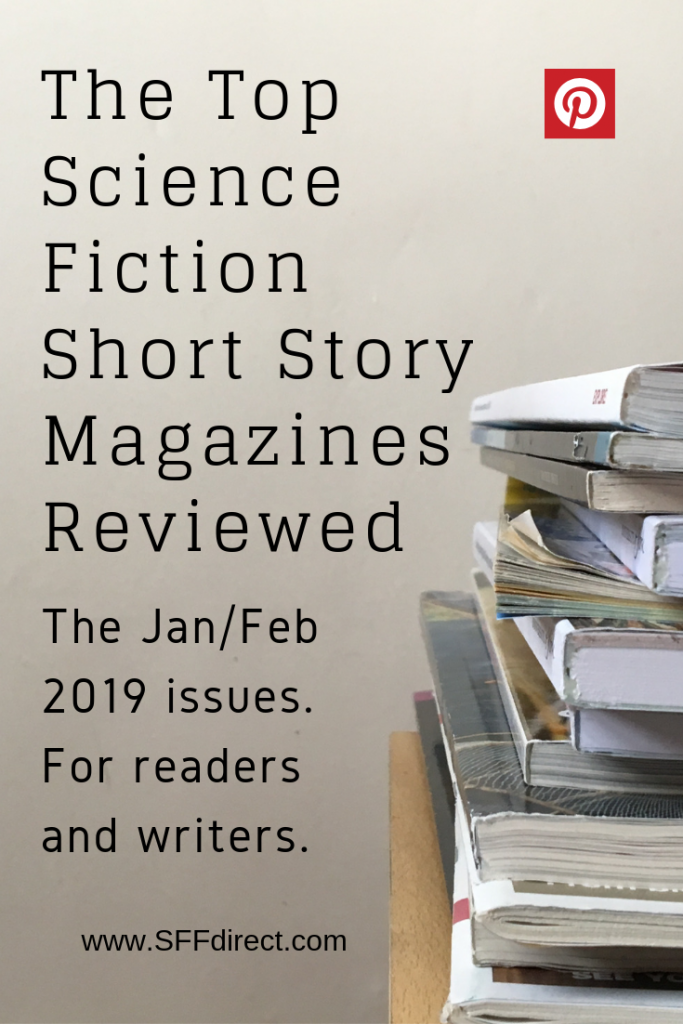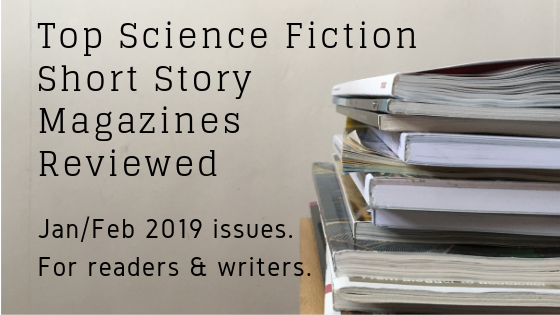SFFdirect reviews the Jan/Feb 2019 issues of the top 9 magazines. For readers and writers.
I read 50 short stories from the top 9 online and print magazines publishing science fiction short stories. The purpose was to become familiar and up-to-date with short SF currently being published, and with the magazines doing this, in the hope it will help me as an SF short story writer.
This article will be twofold: I will review the individual stories and I will comment more generally on the magazines and the genre, giving information and tips for both readers and writers of SF in the hope we can all benefit.
The menu below allows you to jump to different parts of this article. You can skip the ‘selection’ sections if you want to get straight to the results and advice.
Navigation:
Magazine selection
Issue selection
Story selection
Review of the stories
-
The best
-
Runners-up
-
Special mention
-
The worst
Discussion of the magazines
Advice for readers
Advice for writers
Conclusion
Magazine selection
Both online publications and print magazines are called ‘magazines’ in this article. The magazines I chose to look at were:
- Analog Science Fiction and Fact
- Asimov’s Science Fiction
- Magazine of Fantasy and Science Fiction (F+SF)
- Clarkesworld
- Interzone
- Galaxy’s Edge
- Lightspeed
- Andromeda Spaceways Magazine
- Orson Scott Card’s Intergalactic Medicine Show (IGMS)
There is no denying that Analog, Asimov’s and F+SF are the leading players in the SFF short fiction market, but the other six were a subjective choice. I chose them because I believe they are the top magazines currently publishing SF, and taken as a group, the list represents the whole spectrum of fiction across the genre, from pulp to hard SF.
Issue selection
I chose to cover the two month period Jan/Feb 2019. Most of the magazines publish bi-monthly, and I read the Jan/Feb issue. For those which publish monthly, I read both the Jan and the Feb issue, and for the one which publishes quarterly (Andromeda), I read the issue covering Jan and Feb.
The only exception to the Jan/Feb rule was IGMS. It’s bi-monthly but falls on different pairs of months so I read the Dec18/Jan19 issue.
Story selection
I selected science fiction short stories only, so if a magazine published fantasy and/or horror as well as SF I sometimes had to use my judgement whether a story fit this description. For the purposes of this review, I define a short story as anything under 7500 words (I realise this includes flash fiction in the catchment net). Where the publication didn’t give story word counts I had to use my judgement as to whether a story came under the 7500 threshold.
In most cases, I was able to read all the short stories printed by each publication. However, it wasn’t always possible because I would have ended up with more than 50 stories. At a minimum, therefore, I read at least 5 stories for each magazine (or all of them if the magazine didn’t have 5 short stories).
The following spreadsheet shows which stories I read. Each story has a score from 1 – 10, which is my overall score for that story, taking into account readability, how engaging I found it, the strength of the idea or concept, and overall enjoyability.
Review of the stories
The best
The Reality Trip
Every magazine contained at least one story that scored 8 or above. My favourite story of the whole bunch (scoring 10) was ‘The Reality Trip’ by Robert Silverberg in Galaxy’s Edge. It’s written from the perspective of an alien, David, living undercover in New York, and is about his trials as he attempts to rebuff the advances of an extremely amorous human lady, Elizabeth. The tone is lighthearted and David’s voice is wry, with understated humour, and I absolutely loved it! You can feel the alien’s growing desperation as Elizabeth closes in on him. It was written in 1970 and is a reprint, and I find it a shame that the best story of the fifty is something old rather something new, but for me this story is undeniably a clear winner.
Runners-up
Close behind ‘The Reality Trip’ were three stories scoring 9 out of 10. In no particular order, these were ‘All the Difference’ by Leah Cypress, in Asimov’s magazine; ‘Midway’ by Tony Ballantyne in Lightspeed; and ‘For the Wicked, only Weeds Will Grow’ by G. V. Anderson in Interzone. I’ll discuss each in turn.
All the Difference
‘All the Difference’ is set in the near future where technology exists that allows people to switch to an alternate future for a day, a future where they’d made different decisions. They take the place of their other self in that timeline, and it allows them to see what their life could have been like. The story follows a woman desperate to see what her life would have been like if she’d married Steve instead of Jason and it’s very readable. I scored it highly because I think the idea was very good, the story was very readable and suspenseful, and I enjoyed it.
Midway
‘Midway’ is set in the far future about a man who has travelled the galaxy further than anyone else, getting by by selling human culture to the species he comes across. He is the first human to encounter each civilisation he comes across. Or at least he thinks he is until he hears a Beatles song playing in a spaceport and learns that a human woman has been there before him. The ideas, species and settings in this story are well-conceived and I found it very readable and engaging, the characters realistic and plausible.’
For the Wicked, Only Weeds Will Grow
‘For the Wicked, Only Weeds Will Grow’ is written from the perspective of an alien, Mouh. His species is able to release opiates into the bloodstream of any being they are in contact with. The story is set in a hospice for dying beings of many different alien species and centres around the relationship between Mouh and his latest charge, a human called Arnold. The idea was very good and I found the story very readable, and the characters well drawn. It explores the subject of death with sensitivity against an interesting background.
Special mention
Companionship
Finally, I’d like to give a special mention to ‘Companionship’ by Rhiannon Rasmussen in IGMS. It is about a human, Arkaadi, whose ship has crashed into or somehow ended up inside a leviathan creature in space. He is inside the ‘whale’ and survives through the assistance of the ‘whale’s’ leukocytes, which are themselves sentient creatures. It is written in dual perspective; sections by Arkaadi are interleaved with sections by the leviathan. What makes this story special is that the leviathan and its leukocytes are genuinely alien in nature as well as name; I applaud Rasmussen’s imagination and skill in creating a story I found different and mind-expanding yet plausible at the same time.
The worst
Out of the fifty, there were very few stories I could not get on with. Fiction is always a personal thing, but for me, where I scored stories a 2 or 3 it was usually because I didn’t find it readable. What do I mean by this? I mean the style was not easy to read and get into. Either it was too confusing or it was too stale.
Discussion of the magazines
Here I will discuss the style of each magazine. I am probably going to get shot down in flames by people giving myriad examples of where I’m wrong but I’ll have a go anyway!
Analog and Asimov’s
I’ll start with Analog and Asimov’s. They both have what I would call a very readable style. The writing is always almost conversational in nature. In this respect, and because they rarely publish anything genuinely experimental, they are what I would call Mainstream, and there always has to be a strong element of story. The difference between them is that Analog favours stories where the science is uppermost while Asimov’s favours stories where character is uppermost. In analog, every story features, and usually focusses around, a strong scientific concept or piece of technology. In Asimov’s there are always extremely vivid, compelling characters.
Andromeda and IGMS
Staying with the Mainstream, I move now to Andromeda and IGMS. Both of these again have a readable style, often conversational in nature. Andromeda’s stories are usually light in tone and subject matter, and entertaining. There is unlikely to be any heavy subject matter, although the stories sometimes address serious themes below the surface. This is the magazine to find ‘pulp’ science fiction. We all love a bit of pulp, admit it. IGMS only uses content that would pass a PG13 rating, so there won’t be strong language or strong violence. The style is very readable but more experimental styles of story are included.
Clarkesworld and Interzone
Clarkesworld and Interzone lie at the other end of the spectrum. These magazines publish hard science fiction, with Clarkesworld printing a lot of star-spanning fiction set on different planets, with a serious tone. Interzone again usually has a serious tone but publishes quite a bit of experimental fiction. In the past, although I admit not in the issue covered by this review, its stories have sometimes confused me because the style or the society depicted in it is so different.
Lightspeed, Galaxy’s Edge and F+SF
We are left with the magazines that walk the middle ground. These are Lightspeed, Galaxy’s Edge and the Magazine of Fantasy and Science Fiction. I have to admit that before I read the fifty stories, I was less familiar with these magazines than I would have liked. In addition to Mainstream stories, Lightspeed publishes more experimental fiction of the strange type. Indeed, it’s website encourages writers to push the envelope with their submissions. F+SF is probably the more Mainstream of these three magazines; and Galaxy’s Edge is in the middle. It prints a range of stories, including humour.
None of the magazines publish anything I consider truly strange or weird. I deliberately avoided publications that do this for this review, because up to now they’ve not been my cup of tea.
Advice for readers
What I have learnt from this review is just how diverse the SF literary genre is at the moment. The standards of all 9 publications are extremely high and they are publishing a range of material, some magazines playing safer than others. This is all great because whatever you’re looking for there is a magazine for you. I recommend reading a few of them, perhaps using the discussion above as a guide.
Short stories are a different form to novels. If you’re not used to them, I’d say give them a go because they are great fun and the ideas explored in them are often superior to those in novels because writers have a freer rein to take the idea anywhere (unlike market-driven commercial novels), and they don’t have to sustain them in a lengthy narrative.
Our short story magazines are always in need of readers so please support them, and if you can please buy the issue (for example on kindle) even if it’s available free online. The magazines’ websites state how you can buy their issues. SFFdirect purchased every issue reviewed in this article.
Advice for writers
For short story writers, it is important to read as widely in the genre as possible in order to keep current. Read as many stories in as many different magazines as you can.
If you’re looking to place a story then the above discussion will help you decide where your story might fit. Editors repeatedly state in interviews that when they’re considering a story, they are assessing not just the quality of the story but also whether it is the right fit for their magazine. Notwithstanding the discussion above, there is no substitute for reading the publications yourself as quite often the defining characteristics of a magazine are hard to articulate. I have struggled above and will probably issue amendments and/or updates as time goes on.
For information, the word counts each magazine will accept for submissions are stated below. You will see that, with the exception of Galaxy’s Edge they all accept short stories up to 7500 words although not all of them accept flash at the lower end:
- Analog Science Fiction and Fact: up to 20,000
- Asimov’s Science Fiction: 1000 – 20,000
- Magazine of Fantasy and Science Fiction (F+SF): up to 25,000
- Clarkesworld: 1000 – 22,000
- Interzone: up to 20,000
- Galaxy’s Edge: up to 5,000 (to be verified – their website is currently closed for submissions and does not say)
- Lightspeed: 1500 – 10,000
- Andromeda Spaceways Magazine: up to 10,000 for non Aus/NZ authors, up to 20,000 for Aus/NZ authors
- Orson Scott Card’s Intergalactic Medicine Show (IGMS): up to 17,500
Conclusion
Well that closes out my comprehensive review of the top 9 science fiction short story magazines. Please comment below; I look forward to reading your replies.


